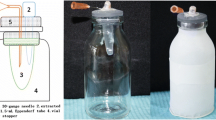Abstract
Objectives
This study aims to evaluate the apical extrusion of debris by the two reciprocating single-file systems: WaveOne and Reciproc. Conventional multi-file rotary system was used as a reference for comparison. The hypotheses tested were (i) the reciprocating single-file systems extrude more than conventional multi-file rotary system and (ii) the reciprocating single-file systems extrude similar amounts of dentin debris.
Materials and methods
After solid selection criteria, 80 mesial roots of lower molars were included in the present study. The use of four different instrumentation techniques resulted in four groups (n = 20): G1 (hand-file technique), G2 (ProTaper), G3 (WaveOne), and G4 (Reciproc). The apparatus used to evaluate the collection of apically extruded debris was typical double-chamber collector. Statistical analysis was performed for multiple comparisons.
Results
No significant difference was found in the amount of the debris extruded between the two reciprocating systems. In contrast, conventional multi-file rotary system group extruded significantly more debris than both reciprocating groups. Hand instrumentation group extruded significantly more debris than all other groups.
Conclusion
The present results yielded favorable input for both reciprocation single-file systems, inasmuch as they showed an improved control of apically extruded debris.
Clinical relevance
Apical extrusion of debris has been studied extensively because of its clinical relevance, particularly since it may cause flare-ups, originated by the introduction of bacteria, pulpal tissue, and irrigating solutions into the periapical tissues.


Similar content being viewed by others
References
De-Deus G, Arruda TEP, Souza EM, Neves A, Magalhães K, Thuanne E et al (1982) The ability of the Reciproc R25 instrument to reach the full root canal working length without a glide path. Int Endod J IN PRESS
Berutti E, Salvatore Paolino D, Chiandussi G, Alovisi M, Cantatore G, Castellucci A et al (2005) Root canal anatomy preservation of WaveOne reciprocating files with or without Glide Path. J Endod
Berutti E, Chiandussi G, Paolino DS, Scotti N, Cantatore G, Castellucci A et al Canal shaping with WaveOne primary reciprocating files and ProTaper system: a comparative study. Journal of endodontics [Internet]. 2012 Apr [cited 2013 Mar 2];38(4):505–509. Available from: http://www.ncbi.nlm.nih.gov/pubmed/22414838
De-Deus G, Brandão MC, Barino B, Di Giorgi K, Fidel RAS, Luna AS Assessment of apically extruded debris produced by the single-file ProTaper F2 technique under reciprocating movement. Oral surgery, oral medicine, oral pathology, oral radiology, and endodontics [Internet]. 2010 Sep [cited 2013 Mar 2];110(3):390–394. Available from: http://www.ncbi.nlm.nih.gov/pubmed/20727500
Bürklein S, Schäfer E (2012) Apically extruded debris with reciprocating single-file and full-sequence rotary instrumentation systems. J Endod [Internet]. Elsevier Ltd; 38(6):850–852. doi:10.1016/j.joen.2012.02.017
McKendry DJ (1990) Comparison of balanced forces, endosonic, and step-back filing instrumentation techniques: quantification of extruded apical debris. J Endod [Internet]. Elsevier Ltd; 16(1):24–27. Available from: http://eutils.ncbi.nlm.nih.gov/entrez/eutils/elink.fcgi?dbfrom=pubmed&id=2388013&retmode=ref&cmd=prlinks
Caviedes-Bucheli J, Moreno JO, Carreño CP, Delgado R, Garcia DJ, Solano J et al (2012) The effect of single-file reciprocating systems on substance P and calcitonin gene-related peptide expression in human periodontal ligament. Int Endod J. doi:10.1111/iej.12005
Schneider SW (1971) A comparison of canal preparations in straight and curved root canals. Oral surgery, oral medicine, and oral pathology [Internet]. Aug;32(2):271–275. Available from: http://www.ncbi.nlm.nih.gov/pubmed/5284110
Kyomen SM, Caputo AA, White SN. Critical analysis of the balanced force technique in endodontics. J Endod [Internet]. 1994 Jul [cited 2013 Mar 3];20(7):332–337. Available from: http://www.ncbi.nlm.nih.gov/pubmed/7996094
Elmsallati E a, Wadachi R, Suda H (2009) Extrusion of debris after use of rotary nickel-titanium files with different pitch: a pilot study. Australian endodontic journal: the journal of the Australian Society of Endodontology Inc [Internet]. Aug [cited 2013 Mar 2];35(2):65–69. Available from: http://www.ncbi.nlm.nih.gov/pubmed/19703077
Conflict of interest
The authors deny any conflict of interest.
Author information
Authors and Affiliations
Corresponding author
Rights and permissions
About this article
Cite this article
De-Deus, G., Neves, A., Silva, E.J. et al. Apically extruded dentin debris by reciprocating single-file and multi-file rotary system. Clin Oral Invest 19, 357–361 (2015). https://doi.org/10.1007/s00784-014-1267-5
Received:
Accepted:
Published:
Issue Date:
DOI: https://doi.org/10.1007/s00784-014-1267-5




